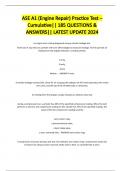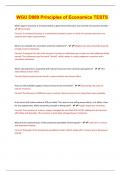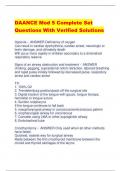ASE A1 (Engine Repair) Practice Test –
Cumulative|| 185 QUESTIONS &
ANSWERS|| LATEST UPDATE 2024
an engine miss is being diagnosed using a cylinder leakage test.
Technician A says that any cylinder with over 20% leakage has excessive leakage. Tech B says that air
leaking from the tailpipe indicates a cracked cylinder.
A only,
B only,
A & B,
Neither . - ANSWER A only:
If cylinder leakage exceeds 20%, check for air escaping the tailpipe, the PCV valve opening in the rocker
arm cover, and the top of the throttle body or carburetor.
Air leaking from the tailpipe usually indicates an exhaust valve leak
during a compression test, a cylinder has 40% of the specified compression reading. When the tech
performs a wet test, the compression reading on this cylinder has 75% of the specified reading. The
cause of the low compression reading could be
worn piston rings,
a burned exhaust valve,
a bent intake valve,
a worn camshaft lobe, - ANSWER worn piston rings
if compression increases during a wet test, this indicates worn piston rings. Compression would not
increase if an exhaust valve is burned, intake valve is bent, or camshaft lobe is worn.
, the customer complains that the engine cranks but does not start; the first thing to check should be
valve train operation,
battery voltage,
compression,
engine vacuum, - ANSWER valve train operation:
if the engine cranks properly, the battery is not the problem. Compression would not be the FIRST test,
and because engine vacuum is low during a crank, a vacuum test would not be conclusive.
during a cylinder balance test on an engine with fuel injection, one cylinder provides very little rpm drop.
Tech A says the ignition system may be misfiring on that cylinder.
Tech B says the engine may have an intake manifold vacuum leak.
A only,
B only,
A & B,
Neither , - ANSWER Both A&B
Both a misfiring ignition system and an intake manifold leak could cause a cylinder to contribute too little
power
while discussing basic diagnostic procedures,
Tech A says the most complicated diagnostic tests should be performed first. Tech B says that you should
first question the customer to obtain as much info as possible about the problem
A,
B,
A & B,
, Neither, - ANSWER B
Always attempt the more simple diagnosis first
low oil pressure would result in a continuous noise
low oil level would result in a continuous noise
worn lifter bottom would result in a continuous noise
when using a compression tester, the readings on the cylinders are all even, but lower than spec. this
could indicate:
blown head gasket,
carbon buildup,
cracked head,
worn rings and cylinders, - ANSWER worn rings and cylinders
-a low reading on two adjacent cylinders may indicate a blown head gasket
-carbon buildup would cause a high reading
-a low reading on two adjacent cylinders may indicate a cracked head
a cylinder balance test is being performed on an engine to determine which cylinder is causing a miss.
Tech A says that when the faulty cylinder is disabled, engine rpm will drop more than for the other
cylinders.
Tech B says disabling the faulty cylinder will cause the engine to stall
A,
B,
Both,
, Neither, - ANSWER Neither
the faulty cylinder will not cause the engine to stall, neither will it cause the engine to drop in RPM since
it is faulty.
an engine is idling at 750 rpm. the pointer on the vacuum gauge is floating between 11 and 16 in Hg. The
most likely cause is
retarded timing,
advanced timing,
stuch EGR valve,
too lean idle mixture, - ANSWER too lean idle mixture
all others would not result in gauge fluctuation
the first step a Tech should take for diagnosis is:
think of possible causes of the problem,
question the customer,
road test the vehicle,
listen to the customer, - ANSWER listen to the customer
the customer says that the engine requires excessive cranking to start. the LEAST likely cause of this
problem would be:
cracked cylinder block,
jumped timing belt,
faulty fuel pump,
stuck-open EGR valve, - ANSWER cracked cylinder block






